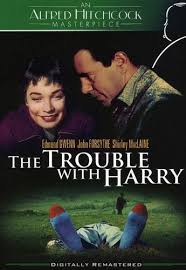
Arnie Rogers (Jerry Mathers) is wandering around the countryside of the village of Highwater, Vermont with his space gun when he hears three shots. Up on a hillside he sees the body of a dead man. While he runs home to tell his mother the man who made the shots, Captain Wiles (Edmund Gwenn) goes looking for the rabbit he was shooting at.
When the Captain sees the dead man on the hillside he believes he is responsible for the man’s death. Knowing it was an accident he decides to hide the body. Before he can, Miss Ivy Gravely (Mildred Natwick) happens by. He explains the accident. Strangely she accepts his explanation and leaves. Then Arnie returns with his mother Jennifer Rogers (Shirley MacLaine). She tells Arnie that the man is Harry Worp (Philip Truex) and he is sleeping. They leave. Next a bum (Barry Macollum) comes by and steals Harry’s shoes. After that Sam Marlowe (John Forsythe) comes by and begins sketching the dead man.
The Captain explains what happened and enlists the aid of Sam to bury Harry. Later the Captain finds out that his third shot may not have hit Harry. They dig him up again. It appears the hole in his head is from a blunt instrument. Miss Gravely confesses that she hit Harry with her heel when he attacked her. Jennifer confesses that Harry was her husband and she hit him with a milk bottle. Well poor Harry ends up buried and dug up a few times before they figure out the best way to handle the trouble with Harry.
“The Trouble With Harry” was released in 1955 and was directed by Alfred Hitchcock. The film is a mystery style black comedy. It was adapted from a novella by British author Jack Trevor Story. At the time the movie tanked in the U.S. Audiences were not use to the black comedy style of filming, especially from Hitchcock.
There is no such town in Vermont called Highwater but location shooting was done in the village of Morrisville and Craftsbury, both located in a section of Northern Vermont referred to as the Northeast Kingdom. Location shots were also done in Barre, Vermont located in the North Central section of Vermont.
Hitchcock had planned to film everything on location however filming in Vermont was hampered by heavy rainfall. Many exterior scenes were filmed on sets constructed in a local high school gymnasium. Much of the dialogue recorded there was inaudible due to the rainfall on the metal roof. As a result a lot of post-recording was necessary. Conditions in Vermont were so dismal that crates of autumn leaves were shipped back to California and were painstakingly pinned onto trees on a studio soundstage. Most of the scenes set in the forest where Harry's body is discovered were shot on a Paramount Pictures soundstage.
This was one of five movies that were unavailable for decades because the rights were bought back by Sir Alfred Hitchcock and left as part of his legacy to his daughter Patricia Hitchcock. They were referred to for years as the infamous "five lost Hitchcocks" amongst movie buffs. They were eventually re-released in theaters in 1984 after almost thirty years unseen. The other four films are Rope (1948), Rear Window (1954), The Man Who Knew Too Much (1956), and Vertigo (1958).
Sir Alfred Hitchcock’s cameo happens during the scene observed through the store window where the millionaire is at the roadside stand looking at Sam’s paintings. Hitchcock is seen walking past the limousine.
Hitchcock insisted on using a real actor for the body of Harry. He chose Philip Truex. His cameo as the deceased title character is his last appearance in a movie. This was Shirley MacLaine’s theatrical debut. She won a Golden Globe for her performance.
The paintings of the character Sam Marlowe were painted by American abstract expressionist artist John Ferren. The sketch of the corpse, Harry Worp, was done on location by Ferren's wife, Rae Ferren.
Quite often “Black comedy” is surreal. That is the case with “The Trouble With Harry”. Characters do not necessarily react that way normal people would. It’s a reflection on the comedy style of the genre. It’s also probably why the film did not go over well with American audiences at the time. Hitchcock’s sense of humor is sometimes missed in his regular work so in this style of comedy it’s no wonder that people just didn’t get it. Fortunately people have come around to the subtle, sometimes dry, humor of Sir Alfred Hitchcock. It is a great example of the genre and a great film by Hitchcock.

